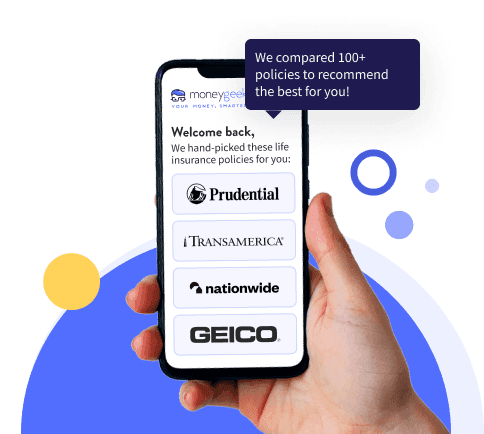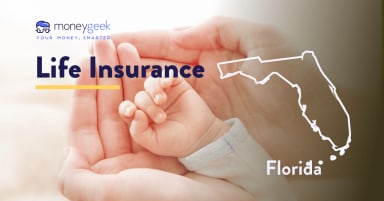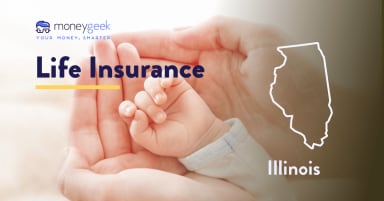Overall, Protective Insurance is the best life insurance company. The ideal provider for you depends on your needs and goals. Below are the top life insurance companies by category to help you decide.
Best Life Insurance Companies in 2025
Protective Insurance, Nationwide, and Ethos are some of the best life insurance companies today. The best option depends on what you're looking for.
Find out if you're overpaying for life insurance below.

Updated: December 9, 2025
Advertising & Editorial Disclosure
Protective Insurance is the best overall life insurance company. The company offers comprehensive coverage, strong consumer and industry ratings, and extensive rider options.
Nationwide ranks second overall and is our top choice for coverage options, offering all main types of life insurance.
Ethos is the third highest ranked overall and earns the top spot for no-exam life insurance.
Ensure you are getting the best rate for your insurance. Compare quotes from the top insurance companies.
Compare the Best Life Insurance Companies
Why Trust Us?
Your needs drive our ratings, not company relationships. Our life insurance experts rate products independently, without any influence from advertisers or financial partnerships. We gathered 1,488 life insurance quotes and combined them with customer satisfaction ratings, financial stability reports, and product offerings to find the best companies for different needs. Read our complete methodology for more information.
Best For | Company | Avg. Monthly Rate | Ages Supported (Term) | Policy Options | Overall MoneyGeek Score |
|---|---|---|---|---|---|
Protective Insurance | $37 (F), $44 (M) | 20-80 | Term, Whole, Universal, IUL | 4.8 | |
Nationwide | $45 (F), $56 (M) | 18-55 | Term, Whole, Universal, IUL, No-Exam | 4.8 | |
Ethos | $54 (F), $72 (M) | 18-69 | Term, Whole, IUL, No-Exam | 4.7 | |
Guardian Life | $40 (F), $51 (M) | 18-75 | Term, Whole, Universal | 4.7 | |
Gerber Life | $47 (F), $53 (M) | 18-70 | Term, Whole, No-Exam | 4.7 | |
North American | $35 (F), $43 (M) | 18-60 | Term, Whole, Universal, IUL | 4.6 | |
SBLI | $37 (F), $48 (M) | 18-75 | Term, Whole | 4.6 | |
Cincinnati Life | $40 (F), $49 (M) | 0-75 | Term, Whole, Universal, No-Exam | 4.6 | |
Transamerica | $37 (F), $46 (M) | 18-85 | Term, Whole, Universal, IUL | 4.6 | |
Legal & General | $38 (F), $47 (M) | 20-75 | Term, Whole, Universal, IUL | 4.5 |
* Rates shown are estimates based on a 40-year old with average weight and height, non-smoker, average health, 20-year term, and $500,000 coverage. Actual rates may vary by state, health profile, and insurer underwriting. Contact insurers directly for personalized quotes.
Explore the best life insurance companies by category:
Best Life Insurance Overall

Avg. Monthly Rate
$37 (F), $44 (M)Ages Supported (Term)
20-80Policy Options
Term, Whole, Universal, IUL
- pros
Offers coverage for ages 20 to 80
Comprehensive policy choices, including IUL options
Coverage amounts that go beyond $10 million
Child term rider increases to five times the original amount at age 25
Conversion options available up to age 70
consRequires a medical exam for all applicants
Term coverage starts only at age 20
Protective Insurance is one of the best overall life insurance companies thanks to its range of coverage options, competitive rates and financial strength. The company serves a wide range of customers, offering term coverage for ages 20 to 80.
It provides both basic term life and indexed universal life (IUL) policies, with coverage amounts that can exceed $10 million. This makes it a strong choice for high-net-worth individuals.
The company also offers many riders for added flexibility. One example is the child term rider, which increases to five times the original amount when the child turns 25, higher than what most competitors provide.
- A.M. Best rating: A+
- NAIC complaint index: N/A
- J.D. Power score: 653 (9th)
- Customer sentiment: 82% positive, 18% negative
- Max coverage: $10 million+
- Medical exam required: Yes
- Terms available: 10-40 years
- Ages supported: 20-80
- Riders and options: Child term rider, accelerated death benefit, waiver of premium, accidental death benefit, guaranteed insurability, conversion options up to age 70
Best Life Insurance Coverage Options

Avg. Monthly Rate
$45 (F), $56 (M)Ages Supported (Term)
18-55Policy Options
Term, Whole, Universal, IUL, No-Exam
- pros
Complete portfolio of all policy types
No-exam coverage up to $1.5 million
Strong J.D. Power ranking (5th place)
Multi-product bundling discounts
Excellent financial ratings across all agencies
consTerm coverage limited to ages 18-55
Higher premiums than other providers in our list
Nationwide ties Protective for our highest score at 4.8, offering one of the most coverage types in our list. If you want options, Nationwide delivers. They're one of the few companies offering every major policy type, including no-medical-exam coverage up to $1.5 million.
Nationwide shines in customer satisfaction with a 5th place J.D. Power ranking and A+ ratings across the board. Plus, their multi-product bundling means you can potentially save money by combining life insurance with your auto or home policies. One key drawback, however, is that their age range for term coverage is more restrictive than most competitors, maxing out at 55.
- A.M. Best rating: A+
- NAIC complaint index: N/A
- J.D. Power score: 666 (5th)
- Customer sentiment: 77% positive, 23% negative
- Max coverage: $10 million+, or $1.5 million without medical exam
- Medical exam required: No
- Terms available: 10-30 years
- Ages supported: 18-55
- Riders and options: Accelerated death benefit, child term rider, waiver of premium, accidental death benefit, return of premium, multi-product bundling
Best No-Exam Life Insurance

Avg. Monthly Rate
$54 (F), $72 (M)Ages Supported (Term)
18-69Policy Options
Term, Whole, IUL, No-Exam
- pros
No medical exam required for coverage up to $3 million
Term options range from 10 to 40 years
Free estate planning tools included
Accelerated death benefits for terminal, critical and chronic illness
consNo traditional universal life policies
Longer term options are limited to younger applicants
Ethos makes getting life insurance straightforward, offering no-exam life insurance coverage up to $3 million and term life insurance options to fit different needs. With a medical exam, the maximum coverage stays the same, which is slightly lower than what some competitors provide.
The company holds A+ ratings from both the BBB and AM Best. Policyholders also get free estate planning tools to help create wills, trusts and power of attorney documents. Term lengths range from 10 to 40 years, though the longer options are available mainly for younger applicants.
- A.M. Best rating: A+
- NAIC complaint index: N/A
- J.D. Power score: N/A
- Customer sentiment: 95% positive, 5% negative
- Max coverage: $3 million without medical exam (Term), $20,000 (Guaranteed Whole)
- Medical exam required: No
- Terms available: 10-40 years (Term)
- Ages supported: 18-69 (Term), 55-85 (Guaranteed Whole)
- Waiting Period (Guaranteed Whole): If death occurs from non-accidental causes within the first 2 years, beneficiaries receive 100% of premiums paid plus 30%.
- Riders and options: Accelerated death benefit, free will and estate planning tools
Best Customer Experience

Avg. Monthly Rate
$40 (F), $51 (M)Ages Supported (Term)
18-75Policy Options
Term, Whole, Universal
- pros
Great customer service (2nd in J.D. Power rankings)
Highest AM Best rating (A++)
Free Charitable Benefit Rider
Strong NAIC complaint record (0.08 index)
Coverage up to $5 million
consNo indexed universal life policies
Medical exam required for all coverage
Limited to traditional policy types
Guardian Life ranks second in J.D. Power’s customer satisfaction study and holds the highest financial strength rating from AM Best (A++), showing a long record of dependability.
The company focuses on traditional life insurance options, including term, whole and universal policies. It doesn’t offer indexed universal life or no-exam coverage, but its plans still provide solid protection and flexibility.
A highlight is the Charitable Benefit Rider, which adds 1% of your death benefit (up to $100,000) to a charity you choose at no extra cost.
- A.M. Best rating: A++
- NAIC complaint index: 0.08
- J.D. Power score: 685 (2nd)
- Customer sentiment: 90% positive, 10% negative
- Max coverage: $5 million
- Medical exam required: Yes
- Terms available: 10-30 years
- Ages supported: 18-75
- Riders and options: Charitable benefit rider, waiver of premium, guaranteed renewability
Best Life Insurance for Children

Avg. Monthly Rate
$47 (F), $53 (M)Ages Supported (Term)
18-70Policy Options
Term, Whole, No-Exam
- pros
No-exam coverage up to $1 million
Specialized child coverage options
Simplified application process
Guaranteed issue options for certain ages
consLimited to basic term and whole life policies
Higher premiums for no-exam coverage
Gerber Life makes getting life insurance easy without medical exams. With a MoneyGeek score of 4.7, the company offers no-exam coverage up to $1 million for people who want to skip needles and doctor visits.
Known primarily for children's life insurance, Gerber brings that same simplified approach to adult coverage. They offer both term and whole life policies without medical underwriting, plus specialized child coverage options that can grow with your family. They are also financially stable, with an A+ AM Best rating, so you can rest easy knowing they’ll be able to pay claims when they come due.
- A.M. Best rating: A+
- NAIC complaint index: N/A
- J.D. Power score: N/A
- Customer sentiment: 81% positive, 19% negative
- Max coverage: $1 million without medical exam (Term), $25,000 (Guaranteed Whole)
- Medical exam required: No
- Terms available: 10-30 years (Term)
- Ages supported: 18-70 (Term), 50-80 (Guaranteed Whole)
- Waiting Period (Guaranteed Whole): N/A
- Riders and options: Accelerated Death Benefit, Child Coverage, Guaranteed Issue Options
Best Whole & Universal Life Insurance

Avg. Monthly Rate
$35 (F), $43 (M)Ages Supported (Term)
18-60Policy Options
Term, Whole, Universal, IUL
- pros
Competitive permanent life insurance options
Full range of cash value policy options
Coverage limits exceeding $10 million
Solid AM Best and BBB ratings
consMedical exams required for all applicants
Limited age range for term coverage (18-60)
Fewer unique features compared to competitors
No detailed rider information available
If you're looking for permanent life insurance that builds cash value, North American offers the best whole life and universal life insurance policies. They also offer competitive indexed universal life options for those wanting market upside potential with downside protection.
North American provides term coverage for 18 to 60-year-olds. While they don't offer no-exam options, their permanent policies provide cash value growth opportunities. North American keeps things straightforward, offering a full range of permanent coverage plans without getting bogged down in complex rider structures.
- A.M. Best rating: A+
- NAIC complaint index: N/A
- J.D. Power score: N/A
- Customer sentiment: 77% positive, 23% negative
- Max coverage: $10 million+
- Medical exam required: Yes
- Terms available: 10-30 years
- Ages supported: 18-60
- Riders and options: N/A
Cheapest Life Insurance

Avg. Monthly Rate
$37 (F), $48 (M)Ages Supported (Term)
18-75Policy Options
Term, Whole
- pros
Competitive premium rates
Coverage available for ages 18-75
High coverage limits ($10 million+)
Essential rider options included
consNo universal or indexed life products
Medical exams required for coverage
Higher NAIC complaint index (1.08)
SBLI (Savings Bank Life Insurance) is one of the cheapest life insurance companies in our list, based on our rate comparison methodology. Originally created to provide affordable coverage to working families, SBLI maintains that mission today.
SBLI offers straightforward term and whole life policies with coverage over $10 million. By keeping things simple, they can focus on competitive pricing while still providing the rider options most people need, including accelerated death benefits, child coverage, and waiver of premium protection. They deliver solid coverage at reasonable prices without unnecessary complexity.
- A.M. Best rating: A
- NAIC complaint index: 1.08
- J.D. Power score: N/A
- Customer sentiment: 80% positive, 20% negative
- Max coverage: $10 million+
- Medical exam required: Yes
- Terms available: 10-30 years
- Ages supported: 18-75
- Riders and options: Accelerated death benefit, child term rider, waiver of premium, accidental death benefit, conversion options from term to permanent coverage
Best Life Insurance Rider Options

Avg. Monthly Rate
$40 (F), $49 (M)Ages Supported (Term)
0-75Policy Options
Term, Whole, Universal, No-Exam
- pros
Coverage available from birth to age 75
Accelerated death benefit for terminal illness AND nursing home care
Extended conversion period to age 70
Partial conversion options available
consNo indexed universal life products
Some riders add significant cost
Cincinnati Life offers more extensive rider options than the other companies in our list. One example is their free accelerated death benefit rider, which covers both terminal illness and nursing home confinement. These are options that most other companies charge extra for.
Cincinnati Life offers coverage from birth to age 75, making them one of the few insurers willing to cover newborns. Their chronic illness rider provides up to $1 million in lifetime benefits, and they allow conversion from term to permanent policies up to age 70. Cincinnati Life’s focus on customizable coverage makes them ideal for families with complex needs.
- A.M. Best rating: A+
- NAIC complaint index: 0.35
- J.D. Power score: N/A
- Customer sentiment: 75% positive, 25% negative
- Max coverage: $10 million+
- Medical exam required: Yes
- Terms available: 10-30 years
- Ages supported: 0-75
- Riders and options: Chronic and terminal illness accelerated benefit rider, disability waiver of premium, accidental death benefit, return of premium, insured insurability rider, child term rider, extended term to permanent conversion period to age 70
Best Age Range

Avg. Monthly Rate
$37 (F), $46 (M)Ages Supported (Term)
18-85Policy Options
Term, Whole, Universal, IUL
- pros
Widest age range (18-85) for term coverage
Multiple product lines for different needs
Built-in living benefits on some policies
Flexible term options (10-30 years)
consMedical exam required
Lower J.D. Power ranking (18th place)
Transamerica covers the highest age of any other life insurance company in our review, offering term coverage from 18 to 85 years old. With an overall MoneyGeek score of 4.6, they make senior life insurance accessible for older people who often struggle to find coverage elsewhere.
Transamerica operates multiple product lines, with their Trendsetter Super Series offering up to $10 million in coverage and their Trendsetter LB plan providing built-in living benefits at no extra cost. Other nice perks include terminal illness benefits automatically applied on larger policies ($50,000+) and flexible conversion options.
- J.D. Power Rating: 615 (18th place)
- AM Best Rating: A
- Average NAIC Complaint Index: N/A
- Customer sentiment: 50% positive, 50% negative
- Max coverage: $10 million, or $100,000 without medical exam
- Medical exam required: No
- Terms available: 10-30 years
- Ages supported: 18-75
- Riders and options: Income protection option, disability waiver of premium, children benefit rider, accidental death benefit, terminal illness accelerated death benefit
Best Term Life Insurance

Avg. Monthly Rate
$38 (F) $47 (M)Ages Supported (Term)
20-75Policy Options
Term, Whole, Universal, IUL
- pros
Includes terminal illness benefits automatically
Extended policy conversion up to age 70
Flexible stacking rider for extra coverage
consMedical exam required for coverage
A bit higher NAIC complaint index (0.35) than others on this list
Legal & General keeps things simple with affordable term life insurance and a long history of reliable service. Its policies are straightforward, with flexible options that adjust as your needs change.
Each plan automatically includes a terminal illness benefit at no extra cost. You can also convert your policy up to age 70, which gives you more time and flexibility than most companies offer.
Another useful feature is the stacking rider, letting you add 10-, 15-, or 20-year layers of coverage as your life evolves, without having to start a new policy.
- A.M. Best rating: A
- NAIC complaint index: 0.35
- J.D. Power score: N/A
- Customer sentiment: 85% positive, 15% negative
- Max coverage: $10 million
- Medical exam required: Yes
- Terms available: 10-40 years
- Ages supported: 20-75
- Riders and options: Accelerated death benefit rider, child rider, stacking rider, guaranteed insurability rider, conversion options to age 70
How Does Life Insurance Work?
Understanding how life insurance works helps you choose a policy that suits your needs. You pay premiums monthly, quarterly, semi-annually or yearly to keep your coverage active. In return, the insurer pays your beneficiaries a death benefit if you pass away while the policy is in effect.
Most policies include a two-year contestability period when the insurer may review claims more closely. After that, your coverage stays valid as long as you continue paying your premiums.
How to Get the Best Life Insurance
Choosing a life insurance policy requires weighing your coverage needs against your budget. Our buying guide helps you find the right policy for your situation.
- Determine how much coverage you need. Calculate how much your family would need to cover debts, replace lost income and maintain their standard of living after your death.
- Compare quotes from multiple insurers. Compare life insurance quotes from at least three to five companies to find competitive rates for your coverage needs and budget.
- Choose between term and permanent life insurance. Term life costs less and covers you for a specific period, while permanent life builds cash value and protects you for your whole life but costs significantly more.
- Check financial strength ratings. Review life insurance company financial strength ratings from AM Best, Moody's or Standard & Poor's to ensure the company can pay claims decades from now when your beneficiaries need the money.
- Understand the underwriting process. Most life insurance providers require a medical exam, health questionnaire and review of your medical records, though some offer simplified or no-exam policies at higher premiums.
- Explore rider options. Your basic life insurance policy will cover the death benefit, but you can add on extras, called riders, that protect you in specific situations. Some common riders include accelerated death benefits for terminal illness, waiver of premium for disability, accidental death benefits, and child coverage riders.
How Much Does Life Insurance Cost?
Life insurance costs vary by coverage amount and buyer profile. The average rate ranges from $33 to $148 for a 40-year-old nonsmoker with average weight and health level. Use the table below to compare average rates for different profiles and term lengths.
| 10 years | $33 | $382 |
| 15 years | $43 | $494 |
| 20 years | $53 | $606 |
| 25 years | $70 | $840 |
| 30 years | $87 | $1,000 |
| 35 years | $101 | $1,216 |
| 40 years | $148 | $1,777 |
*The rates above are based on quotes for 40-year-old nonsmokers with an average health rating. The base coverage amount is $500,000.
Types of Life Insurance
Your life insurance choice affects your family's financial future.
- Term Life Insurance: Term policies last 10 to 30 years and cost less than permanent coverage. They work well for temporary needs like paying off a mortgage or covering children until they're independent. Term policies build no cash value and coverage ends when the term expires. You receive no payout if you outlive the policy.
- Whole Life Insurance: This option covers you for life and builds cash value over time. This permanent coverage combines death benefit protection with a savings component you can borrow against or withdraw from.
- Universal Life Insurance: Choose this one if you want the ability to adjust your premiums and death benefits as your finances change. The policy builds cash value that you can use to pay premiums or borrow against. This type of coverage is ideal for people who want flexibility to modify their policy over time.
- No-Exam Life Insurance: No-exam policies provide immediate coverage without medical testing. You'll pay higher premiums due to the increased risk to insurers, but you can get coverage quickly.
Compare quotes from multiple insurers to find coverage that fits your budget and needs.
Bottom Line
The best life insurance policy for you depends on your goals, health profile, and budget. This guide explains life insurance, who it's for, and how to get the best coverage. It also compares top-rated providers like Protective Insurance, Nationwide, and Ethos, each offering strengths in different aspects. Once you know what affects your rates and take some time to compare plans, you can find the provider that best meets your financial needs.
Ensure you’re getting the best rate for your life insurance. Compare quotes from top providers to find the most affordable coverage available.
Frequently Asked Questions (FAQs)
We answer frequently asked questions to help you find the company offering the best life insurance and learn how to ensure you get the right coverage for your needs.
Is term life insurance or whole life insurance better?
Term life provides higher coverage at lower cost for a specific period, while whole life offers lifetime financial protection with cash value but at five to 15 times higher premiums. Financial experts suggest term life for maximum financial protection at minimum cost.
How does the life insurance medical exam process work?
You'll schedule your medical exam within one to two weeks of applying. A licensed nurse or paramedical examiner visits your home or workplace. The exam includes basic measurements, health questions and blood and urine samples. The insurer receives results within three to five business days.
Can I convert my term life insurance to permanent coverage?
Yes, most term policies let you switch to whole or universal life insurance without a medical exam. You usually have 10 to 20 years from your policy start date to convert, depending on your insurer. Converting gives you permanent coverage but raises your premiums.
Is life insurance taxable?
Death benefits are tax-free to beneficiaries. Interest earned on benefits paid in installments is taxable. Cash value growth in permanent policies is tax-deferred, but loans against cash value can trigger taxes if the policy lapses. Estate taxes may apply to large policies based on ownership structure.
Can I cancel my life insurance policy?
Yes, contact your insurer or agent to cancel your life insurance policy anytime. Term policies have no cash value, so you won't get money back. Permanent policies may have surrender charges and tax implications when you cancel and withdraw cash value.
Our Ratings Methodology
Shopping for life insurance can feel overwhelming, because companies market similar products with confusing terminology and wildly different prices. You need clarity on which insurers deliver value, not just flashy marketing promises. That's why we built a scoring system that cuts through the noise to identify companies that balance affordability with reliability.
Why Trust MoneyGeek?
We reviewed 1,488 life insurance quotes and combined them with customer reviews, financial ratings and coverage details to find the best companies for different types of buyers.
How We Score Life Insurance Companies
MoneyGeek rates life insurance providers based on three important factors. Each company receives a score out of 100 points:
- Affordability (50%): How each insurer’s premium rates compare to others in the market.
- Customer Experience (30%): The quality of service, claims handling and overall satisfaction drawn from customer feedback and industry research.
- Coverage Options (20%): The variety and flexibility of available policies, including riders and customization features to suit different needs.
Our Sample Customer Profile
We used the following standard profile to collect quotes:
- 40-year-old male
- Nonsmoker
- 5 feet, 9 inches tall, 160 pounds
- Average health rating
We used this profile for all premium comparisons unless noted otherwise. We also collected quotes for different ages, genders, health ratings and locations to see how rates vary. This revealed pricing trends across term lengths and coverage amounts and showed which companies offer the best value for each customer type.
Related Pages
More Life Insurance Company Reviews
About Mark Fitzpatrick

Mark Fitzpatrick, a Licensed Property and Casualty Insurance Producer, is MoneyGeek's resident Personal Finance Expert. With over five years of experience analyzing the insurance market, he conducts original research and creates tailored content for all types of buyers. His insights have been featured in publications like CNBC, NBC News and Mashable.
Fitzpatrick holds a master’s degree in economics and international relations from Johns Hopkins University and a bachelor’s degree from Boston College. He's also a five-time Jeopardy champion!
He writes about economics and insurance, breaking down complex topics so people know what they're buying.














